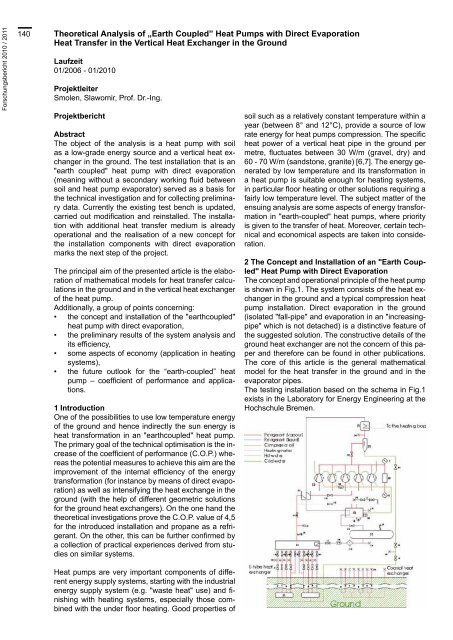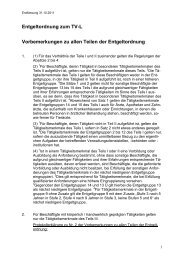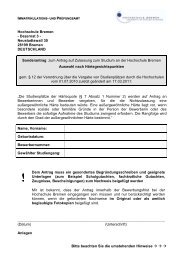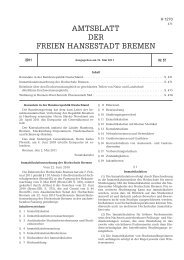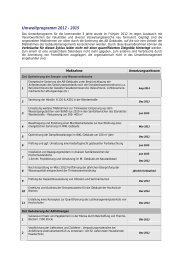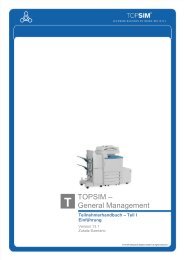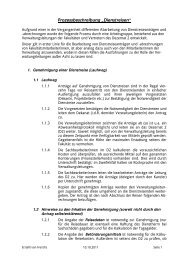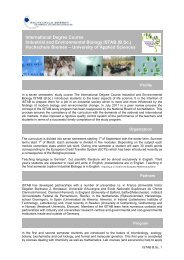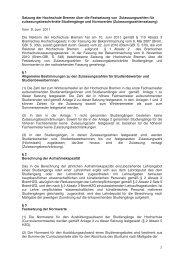Forschungsbericht 2010 - 2011 - Hochschule Bremen
Forschungsbericht 2010 - 2011 - Hochschule Bremen
Forschungsbericht 2010 - 2011 - Hochschule Bremen
Sie wollen auch ein ePaper? Erhöhen Sie die Reichweite Ihrer Titel.
YUMPU macht aus Druck-PDFs automatisch weboptimierte ePaper, die Google liebt.
<strong>Forschungsbericht</strong> <strong>2010</strong> / <strong>2011</strong><br />
140 Theoretical Analysis of „Earth Coupled” Heat Pumps with Direct Evaporation<br />
Heat Transfer in the Vertical Heat Exchanger in the Ground<br />
Laufzeit<br />
01/2006 - 01/<strong>2010</strong><br />
Projektleiter<br />
Smolen, Slawomir, Prof. Dr.-Ing.<br />
Projektbericht<br />
Abstract<br />
The object of the analysis is a heat pump with soil<br />
as a low-grade energy source and a vertical heat exchanger<br />
in the ground. The test installation that is an<br />
"earth coupled" heat pump with direct evaporation<br />
(meaning without a secondary working fluid between<br />
soil and heat pump evaporator) served as a basis for<br />
the technical investigation and for collecting preliminary<br />
data. Currently the existing test bench is updated,<br />
carried out modification and reinstalled. The installation<br />
with additional heat transfer medium is already<br />
operational and the realisation of a new concept for<br />
the installation components with direct evaporation<br />
marks the next step of the project.<br />
The principal aim of the presented article is the elaboration<br />
of mathematical models for heat transfer calculations<br />
in the ground and in the vertical heat exchanger<br />
of the heat pump.<br />
Additionally, a group of points concerning:<br />
• the concept and installation of the "earthcoupled"<br />
heat pump with direct evaporation,<br />
• the preliminary results of the system analysis and<br />
its efficiency,<br />
• some aspects of economy (application in heating<br />
systems),<br />
• the future outlook for the “earth-coupled” heat<br />
pump – coefficient of performance and applications.<br />
1 Introduction<br />
One of the possibilities to use low temperature energy<br />
of the ground and hence indirectly the sun energy is<br />
heat transformation in an "earthcoupled" heat pump.<br />
The primary goal of the technical optimisation is the increase<br />
of the coefficient of performance (C.O.P.) whereas<br />
the potential measures to achieve this aim are the<br />
improvement of the internal efficiency of the energy<br />
transformation (for instance by means of direct evaporation)<br />
as well as intensifying the heat exchange in the<br />
ground (with the help of different geometric solutions<br />
for the ground heat exchangers). On the one hand the<br />
theoretical investigations prove the C.O.P. value of 4,5<br />
for the introduced installation and propane as a refrigerant.<br />
On the other, this can be further confirmed by<br />
a collection of practical experiences derived from studies<br />
on similar systems.<br />
Heat pumps are very important components of different<br />
energy supply systems, starting with the industrial<br />
energy supply system (e.g. "waste heat" use) and finishing<br />
with heating systems, especially those combined<br />
with the under floor heating. Good properties of<br />
soil such as a relatively constant temperature within a<br />
year (between 8° and 12°C), provide a source of low<br />
rate energy for heat pumps compression. The specific<br />
heat power of a vertical heat pipe in the ground per<br />
metre, fluctuates between 30 W/m (gravel, dry) and<br />
60 - 70 W/m (sandstone, granite) [6,7]. The energy generated<br />
by low temperature and its transformation in<br />
a heat pump is suitable enough for heating systems,<br />
in particular floor heating or other solutions requiring a<br />
fairly low temperature level. The subject matter of the<br />
ensuing analysis are some aspects of energy transformation<br />
in "earth-coupled" heat pumps, where priority<br />
is given to the transfer of heat. Moreover, certain technical<br />
and economical aspects are taken into consideration.<br />
2 The Concept and Installation of an "Earth Coupled"<br />
Heat Pump with Direct Evaporation<br />
The concept and operational principle of the heat pump<br />
is shown in Fig.1. The system consists of the heat exchanger<br />
in the ground and a typical compression heat<br />
pump installation. Direct evaporation in the ground<br />
(isolated "fall-pipe" and evaporation in an "increasingpipe"<br />
which is not detached) is a distinctive feature of<br />
the suggested solution. The constructive details of the<br />
ground heat exchanger are not the concern of this paper<br />
and therefore can be found in other publications.<br />
The core of this article is the general mathematical<br />
model for the heat transfer in the ground and in the<br />
evaporator pipes.<br />
The testing installation based on the schema in Fig.1<br />
exists in the Laboratory for Energy Engineering at the<br />
<strong>Hochschule</strong> <strong>Bremen</strong>.


